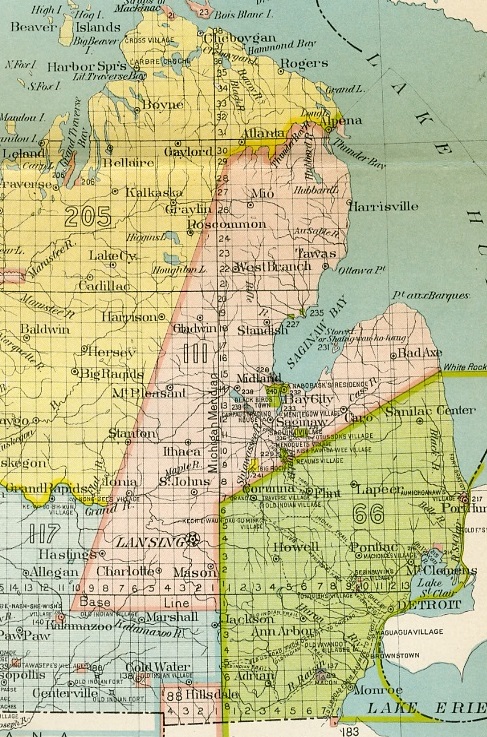As Native American Heritage Month comes to a close, it is important to remember that this year marks the 200th anniversary of the Treaty of Saginaw, signed on September 24, 1819. To mark the signing of the treaty, the Saginaw Chippewa Tribe, on September 24th, observed a sunrise pipe ceremony at the corner of Hamilton and Court Streets in downtown Saginaw, the site of the original treaty grounds. This was followed by a day of presentations and discussions at the Ziibiwing Center of Anishinabe Culture and Lifeways and, that evening, by the opening of an exhibit at the Castle Museum in Saginaw celebrating the area’s Native American origins.
In the 1819 treaty, the U.S. laid claim to over four million acres of land, approximately a third of Michigan’s lower peninsula (shown on the pink shaded area of the map). The Saginaw Chippewa reserved for themselves sections of land within the cession and certain rights to continue living on the ceded territory.
It took thirteen days to negotiate the treaty. The U.S. commissioner, Lewis Cass, governor of Michigan Territory, at the opening council, on September 12th, made it clear that his government wanted considerable cessions of land from the Chippewa. Ogimagegetoo, a forceful young spokesman of the Chippewa, challenged Cass, informing him that they had assembled to sign a peace agreement and not to surrender land. A second meeting, held several days later, nearly ended in violence.
That the negotiations did not fall apart at this point is attributed, by those who have written about the treaty, to the intercession of the traders who were present at the treaty, in particular to Jacob Smith, who had strong ties to the Chippewa. Smith’s actions behind the scenes are not recorded in great detail but hint at the complexity of the negotiations. Smith’s motives were self-serving, at least in part. Considerable ink has been spilled writing about the alleged fraud that occurred during the negotiations when small reserves were set aside at the Grand Traverse (Flint) for Smith’s white children. The intense negotiations at times left tribal leaders divided. Only after the Chippewa had agreed on what lands they would reserve for themselves did the negotiations move forward.
Not enough has been written about the circumstances that led up to the treaty. The political situation at the close of the War of 1812 favored the expansionist ambitions of the United States and accelerated the popular drive of its citizens to occupy land in the west, extending and securing the boundaries of a rising American empire. The Treaty of Ghent, which ended the War of 1812, eliminated the greatest obstacle to U.S. expansionism. In the treaty, Great Britain accepted the borders of the U.S. and withdrew support for an Indian border state lying between Canada and the United States. Native Americans in Michigan were left to come to terms with the United States on their own. They were destitute, exhausted by the war, and abandoned by their British ally. Violent resistance would only lead to more destruction. They could resist U.S. encroachments violently, or they could try to come to an agreement through which they could hope to preserve their way of life.
The 1819 Treaty of Saginaw marked a low point in the history of the Saginaw Chippewa people and the beginning of decades of hardship. The cultural resurgence that has occurred among the Great Lakes Anishinabeg in the last half-century could not even have been contemplated at that time. That resurgence is built on remembering, not forgetting, the past. Remembering the past is not the same as celebrating the past. September 24, 1819, the day the treaty was signed, is not celebrated, but it is remembered.


I would like you to address the ‘Treaty of Peace and Friendship” 1787 and 1836.
This treaty is currently on record at the National Archieves in Washington D.C. It is between George Washington, Minister Plenioplenary and Muhammad Ibd Adullah Sultan of Morocco. This land is The Moroccan Empire, not the kingdom of Morocco. This great earthquake that happened in the 1800 separated the land masses. Never the less, the HR-0689 from Illinois and other States point to fact: The Moors(ish) American are indigenous to the Americas.This treaty is between the Moors and the ‘Christians(European Nations’. This Treaty was talked about by Obama; and even stated the united States Constitution is derived from Moslem Law; the Great Law of Peace…The Librarian stated the Treaty is Still current. I would like to know what is the expiration of the Treaty of Saginaw. These are territorial treaties; the Moroccan Empire comprised of smaller ‘tribes’ of aborigine Moors(not Indians) as stated in 1786/1835 treaties. Our nationality as expressed by government officials is Moors…not Indians(their English description) but ancestorial Moors. The Treaty of Peace and Friendship were only for 50 years and the last one 1834; states it will stand until the one party shall give the other notice to abandon it–thereafter it is good for 12 months. These treaties however old are the Supreme Law of the Land as stated in the “Constitution for the united States”…the organic constitution. Not the revised version. There are 3 constitutions.. The original one under 13th Amendment had 20 parts; describing Africans not being citizens of the U.S. Additionally, the term ‘Indian’ means ward of the state or Corporation. The natural people have a ‘right’ to know who they are as given by the United Nations Rights of Indigenous People. Full disclosure is necessary to live in Harmony. Look forward to dialogue; Pecola007@aol.com
thank you John
Great piece. Lots of interesting info about how tense the treaty negations were.
The only thing I will comment on is that the intersection of Court and Hamilton is not in downtown Saginaw–it is in Old Town Saginaw.
-Sam Fitzpatrick, CMU Alum.